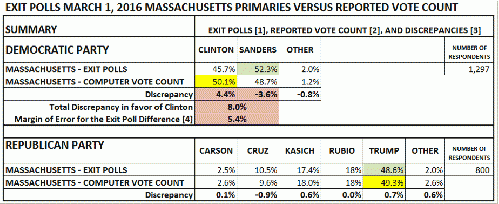In the Massachusetts March 1, 2016 primary Democratic Party race, the computerized vote count declared candidate Clinton the winner but the exit polls indicated candidate Sanders to be the winner by a margin of 6.6%. These same exit polls accurately predicted the results of each and all of the Republican candidates. Until the US joins a long list of many other countries that protect the integrity of their elections through publicly observed hand counting of paper ballots, our elections are liable to be suspect.
Exit polling has been performed in the US and other countries for decades and the science and proper methodology is well established to obtain an accurate prediction of the final vote. For years, many researchers have pointed to the discrepancies between exit poll results and the unverified computer counts in US elections. The main response by the defenders of computerized voting, while expressing blind faith in the unverified computer counting, has been to claim that the exit polls may go wrong because respondents, more enthusiastic for a particular candidate, would be more likely to agree to be polled. The recent Massachusetts Super Tuesday primaries did not support this theory.
[1] Exit polls published by CNN immediately after close of polls.
[2] Reported computer vote count from www.nytimes.com/elections/ results. 100% vote count. Exit poll projected winner is highlighted in green. Reported winner for the state is highlighted in yellow.
[3] Discrepancies are the reported vote count percentage less exit poll percentage. Negative result indicates lower vote count than predicted by the exit polls. Positive result indicates higher vote count than predicted by the exit polls. In contrast to the low discrepancy in the Republican Party race, the discrepancy for the Democratic Party race is much greater than the exit poll margin of error of 5.4% (95% confidence level) for the difference between the two candidates.
[4] Margin of error for differences (at 95% CI) calculated according to: Franklin, C . The 'Margin of Error' for Differences in Polls . University of Wisconsin, Madison, Wisconsin. October 2002, revised February 2007.
The Republican Party primary race has been widely acknowledged as more polarized and contentious than the Democratic Party primary race. In the current election cycle, many Republican Party voters demonstrate enthusiasm for candidate Trump as many Democratic Party voters demonstrate enthusiasm for candidate Sanders. Yet, the exit poll results for the Republican Party closely matched the final computer vote count for every candidate. This accuracy was obtained with about 500 fewer respondents than for the Democratic Party. The higher number of respondents in the Democratic race should lead to a smaller margin of error. The same exit poll for the Democratic race, however, conducted at the same time and the same places, differed widely from the final computer count and the margin of error for the exit poll. This difference turned a Sanders' victory into a defeat.
In US elections, very few precincts conduct verified hand counts of paper ballots. Almost all ballots are counted by computer software hidden from human eyes. In this Massachusetts primary, according to the 68 out of 351 towns that hand counted their ballots, Sanders won overwhelmingly by 17.9% over Clinton (calculated from article's spreadsheet). Although the demographics of these small, mostly rural areas, may have affected these results, the large discrepancy between the hand counted ballots and the unverified computer count certainly raises, in addition to the exit poll discrepancy, further concern and questions.*
A few years ago, MIT Technology Review published the article How to Hack an Election in One Minute reporting on Princeton University's research project Security Analysis of the Diebold AccuVote-TS Voting Machine finding how easy it was to hack into a computer voting system to change the results of an election while remaining totally undetectable. The Brennan Center for Justice at NYU School of Law in their report The Machinery of Democracy: Protecting Elections in an Electronic World found "more than 120 potential threats to [computerized] voting systems."
Due to such concerns, to insure the integrity of public elections, Germany reverted to publicly observed hand counting of paper ballots for all their elections. In 2006 the Federal Constitutional Court of Germany determined that while vote fraud with hand-counted ballots would be easy to detect, "programming errors in the software or deliberate electoral fraud committed by manipulating the software of electronic voting machines can be recognized only with difficulty. The very wide-reaching effect of possible errors of the voting machines or of deliberate electoral fraud make special precautions necessary in order to safeguard the principle of the public nature of elections."
No amount of testing and certifying procedures for the machine counting of votes or the availability of paper trails, post election audits, or recounts could satisfy Germany's constitutional requirement that all important aspects of the electoral process be publicly observable and that "[t]he voters themselves must be able to understand without detailed knowledge of computer technology whether their votes cast are recorded in an unadulterated manner."
Germany is not alone among technologically advanced nations that reject computerized counting in their elections. Countries such as Canada, France, Ireland, Italy, Denmark, Finland and 53 other countries protect the integrity of their elections with hand-counted paper ballots.
As the Massachusetts primaries indicate, the integrity of our elections will be always questionable and suspect until we join the many other countries that safeguard their elections with publicly observed hand counting of paper ballots.
(Note: You can view every article as one long page if you sign up as an Advocate Member, or higher).





